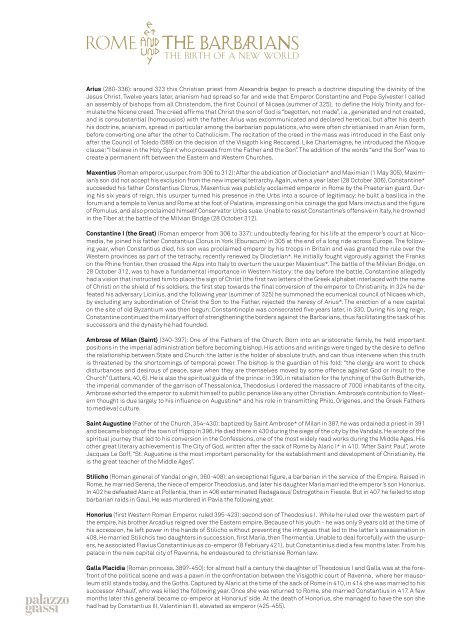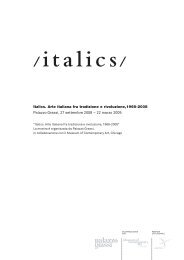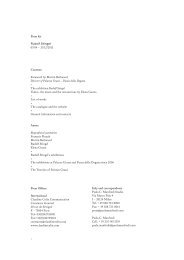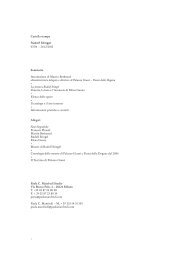pdf file, 819 Kb - Palazzo Grassi
pdf file, 819 Kb - Palazzo Grassi
pdf file, 819 Kb - Palazzo Grassi
You also want an ePaper? Increase the reach of your titles
YUMPU automatically turns print PDFs into web optimized ePapers that Google loves.
Arius (280-336): around 323 this Christian priest from Alexandria began to preach a doctrine disputing the divinity of the<br />
Jesus Christ. Twelve years later, arianism had spread so far and wide that Emperor Constantine and Pope Sylvester I called<br />
an assembly of bishops from all Christendom, the first Council of Nicaea (summer of 325), to define the Holy Trinity and formulate<br />
the Nicene creed. The creed affirms that Christ the son of God is “begotten, not made”, i.e., generated and not created,<br />
and is consubstantial (homoousios) with the father. Arius was excommunicated and declared heretical, but after his death<br />
his doctrine, arianism, spread in particular among the barbarian populations, who were often christianised in an Arian form,<br />
before converting one after the other to Catholicism. The recitation of the creed in the mass was introduced in the East only<br />
after the Council of Toledo (589) on the decision of the Visigoth king Reccared. Like Charlemagne, he introduced the filioque<br />
clause: “I believe in the Holy Spirit who proceeds from the Father and the Son”. The addition of the words “and the Son” was to<br />
create a permanent rift between the Eastern and Western Churches.<br />
Maxentius (Roman emperor, usurper, from 306 to 312): After the abdication of Diocletian* and Maximian (1 May 305), Maximian’s<br />
son did not accept his exclusion from the new imperial tetrarchy. Again, when a year later (28 October 306), Constantine*<br />
succeeded his father Constantius Clorus, Maxentius was publicly acclaimed emperor in Rome by the Praetorian guard. During<br />
his six years of reign, this usurper turned his presence in the Urbs into a source of legitimacy: he built a basilica in the<br />
forum and a temple to Venus and Rome at the foot of Palatine, impressing on his coinage the god Mars invictus and the figure<br />
of Romulus, and also proclaimed himself Conservator Urbis suae. Unable to resist Constantine’s offensive in Italy, he drowned<br />
in the Tiber at the battle of the Milvian Bridge (28 October 312).<br />
Constantine I (the Great) (Roman emperor from 306 to 337): undoubtedly fearing for his life at the emperor’s court at Nicomedia,<br />
he joined his father Constantius Clorus in York (Eburacum) in 305 at the end of a long ride across Europe. The following<br />
year, when Constantius died, his son was proclaimed emperor by his troops in Britain and was granted the rule over the<br />
Western provinces as part of the tetrachy, recently renewed by Diocletian*. He initially fought vigorously against the Franks<br />
on the Rhine frontier, then crossed the Alps into Italy to overturn the usurper Maxentius*. The battle of the Milvian Bridge, on<br />
28 October 312, was to have a fundamental importance in Western history: the day before the battle, Constantine allegedly<br />
had a vision that instructed him to place the sign of Christ (the first two letters of the Greek alphabet interlaced with the name<br />
of Christ) on the shield of his soldiers, the first step towards the final conversion of the emperor to Christianity. In 324 he defeated<br />
his adversary Licinius, and the following year (summer of 325) he summoned the ecumenical council of Nicaea which,<br />
by excluding any subordination of Christ the Son to the Father, rejected the heresy of Arius*. The erection of a new capital<br />
on the site of old Byzantium was then begun: Constantinople was consecrated five years later, in 330. During his long reign,<br />
Constantine continued the military effort of strengthening the borders against the Barbarians, thus facilitating the task of his<br />
successors and the dynasty he had founded.<br />
Ambrose of Milan (Saint) (340-397): One of the Fathers of the Church. Born into an aristocratic family, he held important<br />
positions in the imperial administration before becoming bishop. His actions and writings were tinged by the desire to define<br />
the relationship between State and Church: the latter is the holder of absolute truth, and can thus intervene when this truth<br />
is threatened by the shortcomings of temporal power. The bishop is the guardian of his fold: “the clergy are wont to check<br />
disturbances and desirous of peace, save when they are themselves moved by some offence against God or insult to the<br />
Church” (Letters, 40, 6). He is also the spiritual guide of the prince: in 390, in retaliation for the lynching of the Goth Butherich,<br />
the imperial commander of the garrison of Thessalonica, Theodosius I ordered the massacre of 7000 inhabitants of the city.<br />
Ambrose exhorted the emperor to submit himself to public penance like any other Christian. Ambrose’s contribution to Western<br />
thought is due largely to his influence on Augustine* and his role in transmitting Philo, Origenes, and the Greek Fathers<br />
to medieval culture.<br />
Saint Augustine (Father of the Church, 354-430): baptized by Saint Ambrose* of Milan in 387, he was ordained a priest in 391<br />
and became bishop of the town of Hippo in 396. He died there in 430 during the siege of the city by the Vandals. He wrote of the<br />
spiritual journey that led to his conversion in the Confessions, one of the most widely read works during the Middle Ages. His<br />
other great literary achievement is The City of God, written after the sack of Rome by Alaric I* in 410. “After Saint Paul”, wrote<br />
Jacques Le Goff, “St. Augustine is the most important personality for the establishment and development of Christianity. He<br />
is the great teacher of the Middle Ages”.<br />
Stilicho (Roman general of Vandal origin, 360-408): an exceptional figure, a barbarian in the service of the Empire. Raised in<br />
Rome, he married Serena, the niece of emperor Theodosius, and later his daughter Maria married the emperor’s son Honorius.<br />
In 402 he defeated Alaric at Pollentia, then in 406 exterminated Radagaisus’ Ostrogoths in Fiesole. But in 407 he failed to stop<br />
barbarian raids in Gaul. He was murdered in Pavia the following year.<br />
Honorius (first Western Roman Emperor, ruled 395-423): second son of Theodosius I. While he ruled over the western part of<br />
the empire, his brother Arcadius reigned over the Eastern empire. Because of his youth - he was only 9 years old at the time of<br />
his accession, he left power in the hands of Stilicho without preventing the intrigues that led to the latter’s assassination in<br />
408. He married Stilicho’s two daughters in succession, first Maria, then Thermantia. Unable to deal forcefully with the usurpers,<br />
he associated Flavius Constantinius as co-emperor (8 February 421), but Constantinius died a few months later. From his<br />
palace in the new capital city of Ravenna, he endeavoured to christianise Roman law.<br />
Galla Placidia (Roman princess, 389?-450): for almost half a century the daughter of Theodosius I and Galla was at the forefront<br />
of the political scene and was a pawn in the confrontation between the Visigothic court of Ravenna, where her mausoleum<br />
still stands today, and the Goths. Captured by Alaric at the time of the sack of Rome in 410, in 414 she was married to his<br />
successor Athaulf, who was killed the following year. Once she was returned to Rome, she married Constantius in 417. A few<br />
months later this general became co-emperor at Honorius’ side. At the death of Honorius, she managed to have the son she<br />
had had by Constantius III, Valentinian III, elevated as emperor (425-455).
















